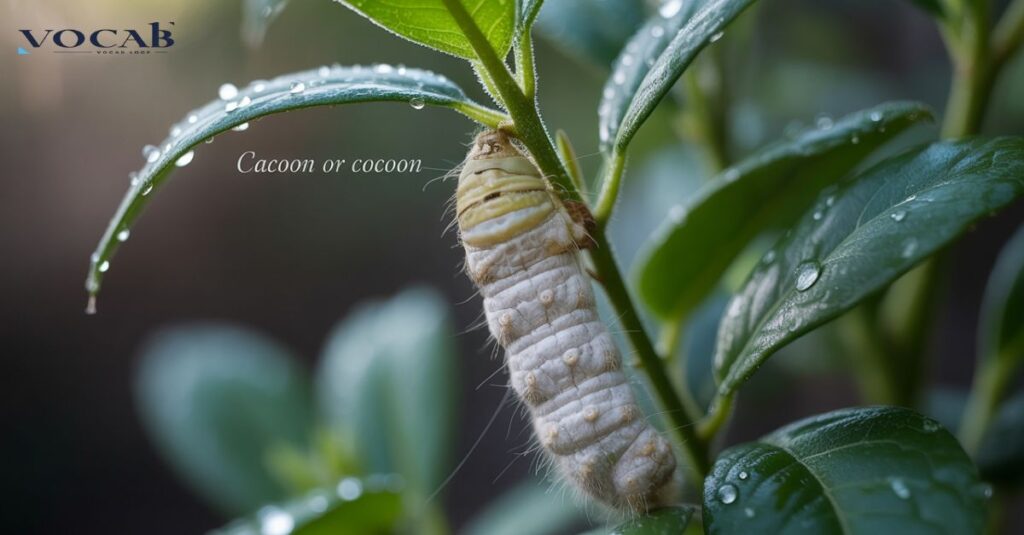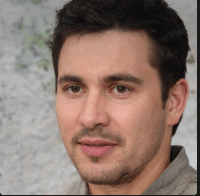Choosing between cacoon or cocoon can be tricky. Both sound almost the same, but only one is widely used in everyday English. If you’ve ever paused mid-sentence wondering whether you’re spelling it right, you’re not alone. This article clears up the spelling confusion, explains their origins, and explores why so many people make this common mistake.
English is full of homophones—words that sound alike but are spelled differently or have different meanings. These often lead to misspelled words in English, especially when the two versions seem like variations of the same idea. But in the case of cacoon vs cocoon, there’s a clear winner depending on what you’re trying to say.
Why Is There Confusion in Cacoon or Cocoon
The confusion between cacoon or cocoon mostly happens because both words are pronounced similarly. This leads many people to assume that “cacoon” might be just another version or an alternative spelling of “cocoon.” In fact, many spell-checkers don’t even catch the error unless the context is very specific.
Another reason for this mix-up is that English accepts different spellings of the same word depending on the region, like color vs colour. But in this case, there is no regional variation. “Cocoon” is the standard word accepted in American and British English for describing a protective casing made by insects. “Cacoon” is something else entirely, and we’ll break that down next.
What Does Mean of Cacoon
The meaning of cacoon is very different from “cocoon.” “Cacoon” refers to the cacoon bean, a seed from the snuffbox bean plant also known by its scientific name Fevillea cordifolia. This tropical plant grows in parts of Central America, the Caribbean, and West Africa. The bean is often used in traditional medicine and local remedies, especially in Jamaica and Nigeria.
It gets the name “snuffbox bean” because people used to hollow it out and store powdered tobacco (snuff) inside it. In many Caribbean markets, these beans were sold as containers and sometimes even as jewelry or keepsakes. So while it’s a real word with cultural value, cacoon belongs in the world of botanical terminology, not in insect science.
What Does Mean of Cocoon
The word cocoon is a household term and appears in science books, furniture design, and even daily speech. The cocoon definition in biology refers to the protective shell spun by insects like moths or silkworms during the transformation stage in insects. This process is called insect metamorphosis, where a larva transforms inside the cocoon into an adult moth or butterfly.
Outside of science, “cocoon” has grown into a metaphor. People often say they’re in a metaphorical cocoon when they want to describe isolation and comfort. It’s also a popular idea in design—like the cocoon chair or cocoon furniture that surrounds you in a cozy, private space. So, the cocoon meaning in English goes far beyond bugs—it’s about warmth, safety, and transformation.
Quick Summary between Cacoon or Cocoon
To make things simple, here’s a quick comparison of both words:
| Word | Meaning | Usage | Origin |
| Cocoon | Protective shell made by insects | Insects, furniture, metaphor | Latin/Greek |
| Cacoon | Bean from a tropical plant | Traditional medicine, cultural | African (Yoruba) |
From the table, it’s clear that cocoon is the correct spelling for anything related to insects or cocoon metaphor expressions. The word cacoon, while valid, only refers to a botanical term cacoon used in very specific regions.
Pronunciation of Cacoon or Cocoon
The pronunciation of both words is nearly the same: /kəˈkuːn/. That’s part of why so many people make the mistake of spelling “cocoon” as “cacoon.” They sound identical when spoken aloud, especially in fast conversation.
But despite sounding the same, they are different words with unrelated meanings. This makes them English homophones, which often create confusion among learners and native speakers alike.
Spelling and Visual Cues of Cacoon or Cocoon
To figure out how to spell cocoon correctly, look for visual clues. The word “cocoon” has repeating “o”s, which gives a round, smooth look—much like the actual object it describes. On the other hand, “cacoon” seems off visually because it starts with “ca,” which doesn’t relate to insects at all.
Also, if you type “cacoon” into a word processor, most systems underline it in red. That’s because “cacoon” is not widely recognized except in botanical terminology. So let your eyes guide you—cocoon just looks more natural in the English language.
Key Difference between Cacoon or Cocoon

The difference between cocoon and cacoon lies in meaning, usage, and familiarity. A cocoon is known by nearly everyone and shows up in textbooks, home décor, and self-help books. It’s a noun and sometimes a verb (“to cocoon oneself”).
On the other hand, cacoon is extremely rare. Unless you’re studying the cacoon plant usage in botany or West African culture, you’re unlikely to ever use or see this word. So when in doubt, stick to “cocoon.”
Comparison Table between Cacoon or Cocoon
| Feature | Cocoon | Cacoon |
| Category | Insect biology, metaphor | Tropical seed/bean |
| Scientific Link | Silkworm cocoon, butterfly | Fevillea cordifolia |
| Uses | Cocoon in insects, furniture, speech | Traditional medicine, crafts |
| Common in USA? | Yes | No |
| Part of speech | Noun, Verb | Noun only |
Common Mistakes in Cacoon or Cocoon
The most common error is assuming “cacoon” is an acceptable spelling of “cocoon.” Many people write it that way due to how it sounds, especially when typing quickly or using voice-to-text tools. These kinds of misspelled words in English are common, especially with words that look and sound similar.
Social media and informal messaging have made this mistake even more common. But if you’re writing a paper, blog post, or message with care, always choose cocoon unless you’re talking about the Yoruba term for cacoon.
Formal vs Informal Usage of Cacoon or Cocoon
In formal writing—like school essays, scientific reports, or professional documents—the word “cacoon” should be avoided unless you’re specifically discussing the cacoon bean. For all other contexts, especially those involving insects or comfort, cocoon is correct.
Even in informal usage, like texting or speaking casually, “cocoon” is the word people understand. Using “cacoon” might confuse your reader or sound like a typo. So for both settings, cocoon is usually the better and safer choice.
Usage in Different English Varieties Cacoon or Cocoon
Across different English dialects, the word cocoon remains the standard spelling. Whether you’re in the USA, UK, Canada, or Australia, dictionaries and style guides all agree on “cocoon.” There is no recognized regional spelling as “cacoon” in standard English.
“Cacoon” is used only in specific cultural or botanical contexts, mainly in West Africa or Caribbean regions where the cultural significance of cacoon is well known. So if you’re speaking global English, cocoon should always be your go-to.
Simple Trick to Remember the Difference of Cacoon or Cocoon

An easy way to remember is this: “A caterpillar cocoons, not cacoons.” The double “o” in “cocoon” can also remind you of its round shape and snug feel, just like a protective shell. If it sounds cozy, it’s “cocoon.”
Another trick is to think of cocoon comfort metaphor in furniture—like a cocoon chair or blanket. Nobody ever markets a “cacoon” chair!
Examples in Sentences
Cacoon:
- The cacoon bean is used in traditional Jamaican medicine.
- I bought a cacoon necklace at the local market.
- The locals explained the healing power of the cacoon.
- He carved a box from a dry cacoon shell.
- “Certain communities use crushed cacoon seeds in traditional skin treatments.”
- We studied the Fevillea cordifolia in our botany class.
- That fruit belongs to the snuffbox bean plant.
- She dried the cacoon bean in the sun for tea.
- The tropical plant grew wild in the backyard.
- Old recipes include the powdered form of cacoon.
Cocoon:
- The caterpillar spun a cocoon on the tree branch.
- He stayed in a cocoon of silence all weekend.
- The silk from the silkworm cocoon is very fine.
- I wrapped myself in a blanket like a cocoon.
- The spa offers a cocoon experience for relaxation.
- She used a cocoon chair to work from home.
- A butterfly breaks free from its cocoon.
- That child lives in a metaphorical cocoon.
- Their love formed a warm protective casing.
- The house felt like a cocoon of peace.
Synonyms of Cacoon or Cocoon
Cacoon:
- Snuffbox bean
- Fevillea nut
- West Indian pod
- Tropical seed
- Seed pod container
- Natural snuff case
- Jungle seed
- Flat vine bean
- Caribbean shell
- Botanical fruit
Cocoon:
- Protective shell
- Chrysalis
- Silk wrap
- Pupal case
- Sanctuary
- Refuge
- Shelter
- Covering
- Wrap
- Haven
Origins of Cacoon or Cocoon
Cacoon
The word “cacoon” has its roots in the Yoruba term for cacoon and is found in parts of Africa and the Caribbean. This botanical term cacoon came into English through cultural exchange, trade, and colonial texts. First recorded in the 18th century, cacoon referred only to the bean and not to insects or silk.
Its value in traditional medicine and use as a natural container gave it importance in rural life. However, it never entered mainstream English the way “cocoon” did.
Cocoon:
The word “cocoon” comes from French “cocon,” which traces back to Latin and Greek roots meaning “berry” or “seed.” This makes sense since early cocoons looked like berries. It became widely known during the growth of the silk production industry.
Over time, it moved beyond science into homes, emotions, and design. The history of the word cocoon shows how words evolve as their meanings expand through new experiences.
Fun Fact about Cacoon or Cocoon
Did you know a silkworm cocoon can be unwound into a single thread over 1,000 yards long? And the cacoon bean was once used as a mini purse by Caribbean women. Both serve as protective casings, but in very different ways!
FAQ’s
Is it a cocoon or chrysalis?
A chrysalis is the pupa stage of a butterfly, while a cocoon is a silk casing created by moths to protect their pupa.
Is a moth a butterfly?
No, a moth is not a butterfly. They are related but belong to different groups within the Lepidoptera order.
Is a butterfly chrysalis alive?
Yes, the chrysalis is alive. Inside it, the caterpillar is transforming into a butterfly through metamorphosis.
Are cocoons eggs?
No, cocoons are not eggs. They are protective shells spun by moths to surround the pupa, not the egg stage.
What is another name for chrysalis?
Another word for chrysalis is pupa or pupal case, often used in entomology.
Conclusion
When it comes to cacoon or cocoon, the choice depends on what you’re describing. If you’re talking about insect metamorphosis, cocoon furniture, or a cocoon comfort metaphor, the correct spelling is always cocoon. But if you’re speaking about a tropical plant or the cacoon bean, then “cacoon” is right.
Still, in 99% of cases, especially in American English, the correct form is “cocoon.” So next time you’re writing, remember the difference between cocoon and cacoon, and let the spelling wrap around your meaning like a snug, perfect shell.

Alex Hormozi is a seasoned blogger at Vocab Loop, known for his deep insights into language, vocabulary, and grammar. With years of experience in writing, Alex shares practical tips and effective strategies to help readers improve their linguistic skills and enhance their writing abilities.

